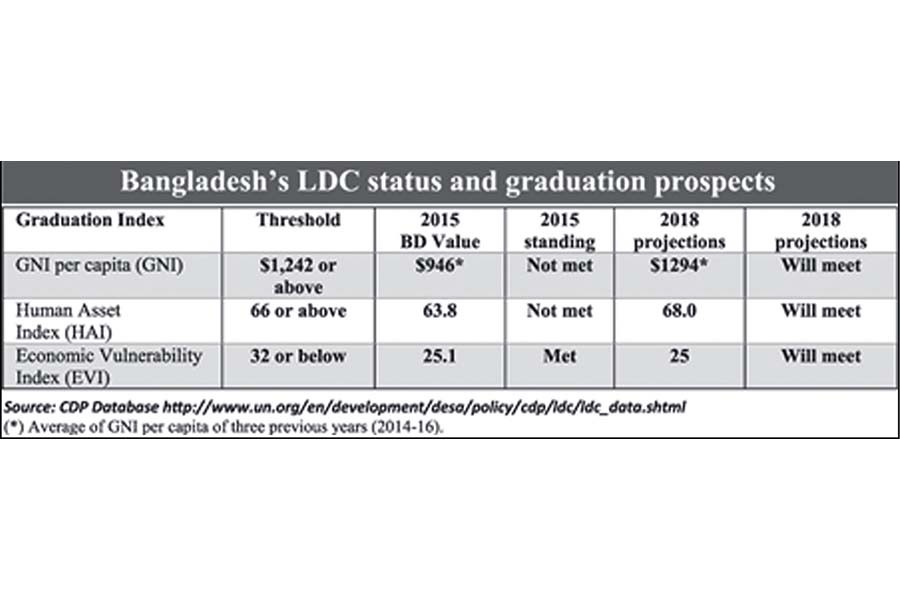Progress Towards LDC Graduation: Government's Commitment

Table of Contents
Economic Growth and Diversification as Pillars of LDC Graduation
Sustainable economic growth and diversification are cornerstones of LDC graduation. Governments play a crucial role in fostering this growth through targeted investments and policy reforms.
Investment in Infrastructure
Robust infrastructure is the backbone of any thriving economy. Government investment in roads, energy, communication networks, and other essential infrastructure is paramount for supporting economic diversification and attracting foreign direct investment (FDI).
- Examples of successful infrastructure projects: The expansion of the Rwandan road network has facilitated trade and reduced transportation costs. Similarly, investments in renewable energy infrastructure have boosted power access in several graduating nations.
- Impact on trade and investment: Improved infrastructure significantly reduces the cost of doing business, attracting both domestic and foreign investment. This leads to increased trade opportunities and economic expansion.
- Challenges faced in infrastructure development: Securing sustainable financing, managing complex projects, and addressing environmental considerations are ongoing challenges in infrastructure development.
Promoting Private Sector Development
A vibrant private sector is essential for driving economic growth and job creation. Governments can significantly contribute by creating a favorable business environment. This includes reducing bureaucratic hurdles, streamlining regulations, improving access to finance, and fostering innovation.
- Examples of successful private sector initiatives: Government support programs for small and medium-sized enterprises (SMEs) have spurred entrepreneurship and job growth in many LDCs.
- Government support programs: Tax incentives, access to credit facilities, and business development services are crucial government interventions in boosting private sector growth.
- Challenges in promoting private sector growth: Addressing corruption, improving contract enforcement, and fostering a culture of entrepreneurship remain key challenges.
Sustainable Agriculture and Resource Management
Sustainable agriculture and responsible natural resource management are vital for long-term economic stability and food security. Governments must invest in climate-smart agricultural practices, protect natural resources, and promote sustainable land use.
- Examples of successful agricultural programs: Investing in irrigation systems, promoting drought-resistant crops, and supporting farmer cooperatives have improved agricultural productivity and incomes in several LDCs.
- Impact on food security and income generation: Sustainable agricultural practices contribute to improved food security, increased farmer incomes, and reduced poverty.
- Challenges in sustainable resource management: Addressing climate change impacts, combating deforestation, and promoting sustainable fishing practices are crucial ongoing efforts.
Human Capital Development: A Key Driver for LDC Graduation
Investing in human capital—through education and healthcare—is fundamental for LDC graduation. A healthy, skilled, and educated population is the engine of economic growth and social progress.
Investment in Education and Healthcare
Quality education and healthcare are critical for building a productive workforce and a healthy society. Governments must invest in expanding access to quality education at all levels, improving healthcare infrastructure, and strengthening primary healthcare services.
- Examples of successful education and healthcare programs: Universal primary education programs have significantly increased literacy rates in many LDCs. Improvements in maternal and child health services have also dramatically improved health indicators.
- Improvements in literacy and health indicators: Increased literacy rates correlate with higher productivity, economic growth, and improved quality of life. Better health outcomes contribute to a healthier and more productive workforce.
- Challenges in accessing quality education and healthcare: Geographical barriers, inequitable access, and inadequate funding remain significant challenges.
Skills Development and Training
Equipping the workforce with relevant skills is critical for successful participation in a modern economy. Government initiatives focused on skills development and vocational training are vital for bridging the skills gap and creating employment opportunities.
- Examples of successful skills development programs: Government-funded vocational training programs aligned with market demands have successfully created employment opportunities for many young people.
- Alignment with market demands: Skills development programs must be closely aligned with the needs of the labor market to ensure that graduates have the skills employers need.
- Challenges in skills mismatch: Addressing skills mismatches through effective labor market information systems and adaptable training programs is essential.
Good Governance and Institutional Capacity Building
Effective governance and strong institutions are essential for attracting investment, ensuring transparency and accountability, and implementing development policies effectively.
Strengthening Governance Structures
Transparent, accountable, and participatory governance is vital for attracting FDI and building trust. Governments must combat corruption, strengthen the rule of law, and promote good governance practices.
- Examples of reforms in governance: Implementing anti-corruption measures, strengthening judicial independence, and promoting citizen participation in governance have resulted in improved governance in several LDCs.
- Combating corruption: Corruption diverts resources away from development priorities and undermines investor confidence. Strong anti-corruption measures are crucial for sustainable development.
- Enhancing transparency and accountability: Open government initiatives, promoting access to information, and strengthening oversight mechanisms enhance accountability.
Capacity Building for Public Institutions
Effective public institutions are crucial for implementing development policies and delivering public services efficiently. Governments must invest in building the capacity of public institutions to effectively manage resources and deliver services.
- Examples of capacity-building initiatives: Training programs for public officials, strengthening financial management systems, and promoting e-governance initiatives improve public service delivery.
- Improvements in public service delivery: Effective public institutions are essential for efficient delivery of essential services, such as healthcare, education, and infrastructure development.
- Challenges in institutional capacity building: Lack of resources, insufficient training, and political interference are major challenges in building institutional capacity.
Conclusion
LDC graduation requires a sustained and comprehensive effort from governments. Investing in infrastructure, promoting private sector development, ensuring sustainable agriculture, building human capital, and strengthening governance are all interconnected and vital elements. Continued commitment to these areas, coupled with effective policy implementation and international support, is essential for achieving LDC graduation and building sustainable and prosperous nations. Learn more about how your government is contributing to LDC graduation and explore ways you can support this crucial initiative. [Link to relevant resources]

Featured Posts
-
 Waarom Jenna Ortega Scream 7 Verliet De Rol Van Melissa Barrera
May 07, 2025
Waarom Jenna Ortega Scream 7 Verliet De Rol Van Melissa Barrera
May 07, 2025 -
 Court Appointed Monitor Suggests Lion Electric Liquidation
May 07, 2025
Court Appointed Monitor Suggests Lion Electric Liquidation
May 07, 2025 -
 Lotto 6aus49 Vom 19 April 2025 Die Lottozahlen Von Heute
May 07, 2025
Lotto 6aus49 Vom 19 April 2025 Die Lottozahlen Von Heute
May 07, 2025 -
 Unbelievable Catch Mariners Outfielders Heroic Play Against Giants
May 07, 2025
Unbelievable Catch Mariners Outfielders Heroic Play Against Giants
May 07, 2025 -
 Addressing The I Dont Know Where You Are Crisis In Air Traffic Control
May 07, 2025
Addressing The I Dont Know Where You Are Crisis In Air Traffic Control
May 07, 2025
